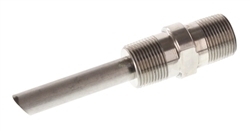Hello every one,
We have field diesel distillation unit and we have plan to inject pour point chemical to heavy oil product ( Residual) which goes to crude tanks for storage. I have some concerns about injection point orientation.
As good practice we normaly inject the chemical on the top of the pipe but in our case only we have a drain fitting at lower position 6 clocks (6 inch pipe).
It is ok to carry out this job.
please see attached file (our Chemical Quill will be used)
Zayed
We have field diesel distillation unit and we have plan to inject pour point chemical to heavy oil product ( Residual) which goes to crude tanks for storage. I have some concerns about injection point orientation.
As good practice we normaly inject the chemical on the top of the pipe but in our case only we have a drain fitting at lower position 6 clocks (6 inch pipe).
It is ok to carry out this job.
please see attached file (our Chemical Quill will be used)
Zayed

